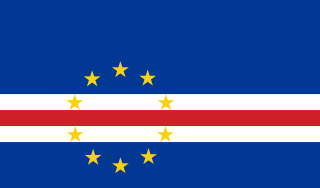
Cap-Vert, or the Cape Verde Peninsula, is a peninsula in Senegal and the westernmost point of the continent of Africa and of the Afro-Eurasia mainland. Portuguese explorers called it Cabo Verde or "Green Cape". The Cape Verde islands, 570 kilometres (350 mi) further west, are named after the cape. Dakar, the capital of Senegal, occupies parts including its southern tip.

Pico do Fogo[ˈpiku du ˈfoɡu] is the highest peak of Cape Verde and West Africa, rising to 2,829 metres (9,281 ft) above sea level. It is an active stratovolcano lying on the island of Fogo. The main cone last erupted in 1680, causing mass emigration from the island. A subsidiary vent erupted in 1995. The only deadly eruption was in 1847 when earthquakes killed several people.
Dinis Dias was a 15th-century Portuguese explorer.

Pedra de Lume is a village in the northeastern part of the island of Sal, Cape Verde. The village is situated on the east coast, about 5 km east of the island capital Espargos. It has a small port and a lighthouse, Farol de Pedra de Lume.
Tabanka is a musical genre of Cape Verdean music.

Cape Verde or Cabo Verde, officially the Republic of Cabo Verde, is an archipelago and island country in the central Atlantic Ocean, consisting of ten volcanic islands with a combined land area of about 4,033 square kilometres (1,557 sq mi). These islands lie between 600 and 850 kilometres west of Cap-Vert, the westernmost point of continental Africa. The Cape Verde islands form part of the Macaronesia ecoregion, along with the Azores, the Canary Islands, Madeira, and the Savage Isles.

Pointe des Almadies or Point Almadies is the westernmost point on the continent of Africa and the Old World. Pointe des Almadies is located on the north-western end of the Cap Vert peninsula in Senegal.

The National Library of Cape Verde is located in Praia, Cape Verde. The library was established in 1999. The library maintains the National Bibliography, contains the country's historical archives and the theses and dissertation bank and is a legal deposit. It also serves as the public library of Praia, the country's capital.
Conus dorotheae is a species of sea snail, a marine gastropod mollusc in the family Conidae, the cone snails and their allies.
Cape Verde, in Portuguese Cabo Verde, is an island country in West Africa.
École Internationale Les Alizés is a French international school in Praia, Cape Verde located at Avenida ONU in the neighbourhood of Achada Santo António. It serves levels maternelle (preschool) through lycée, directly teaching maternelle and primaire (elementary) levels and using the distance education programme from the National Centre for Distance Education (CNED) for collège and beyond.

The Festival de Baía das Gatas or the Baía das Gatas Festival and the Baía das Gatas Music Festival takes place on a full moon weekend in August in Baía das Gatas, a village and a bay in the northeastern part of the island of São Vicente, Cape Verde. It is the most popular music festival in Cape Verde and are likely being the first, in its early years, it was the only music festival in the country until the Festival de Gamboa which was established in 1992 in Praia in the island of Santiago. It is nicknamed the Woodstock of Africa.
Certeza was a Cape Verdean literary review established in Praia in 1944. Although the paper was less notoriety than its predecessor Claridade founded in 1936, nevertheless, it was a milestone in Cape Verdean literature.
Manuel Veiga is a Cape Verdean writer, a linguist with references in the national and international level and a politician. He was minister of culture of his country from 2004 to 2011.

Cape Verde–France relations are the bilateral relations between France and Cape Verde.
The following lists events that happened during 1944 in Cape Verde.
Cap-Vert is a volcanic field in Senegal with a surface of 100 square kilometres (39 sq mi). The field covers the Cape Verde peninsula close to Dakar and was active until 600,000 years ago. It consists of a number of outcrops and two 100 metres (330 ft) high hills. The position of the dykes and lava flows has been influenced by local fault systems.
This page is based on this
Wikipedia article Text is available under the
CC BY-SA 4.0 license; additional terms may apply.
Images, videos and audio are available under their respective licenses.







